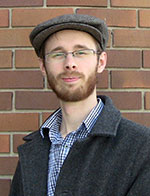
I’ve mentioned before that I did a radio interview on visiting the Holy Land and wrote a few blog posts during the trip at The Canadian Lutheran. That material was fodder for a larger article I was working on, which appeared in the March/April issue of The Canadian Lutheran. The article is entitled “Where Jesus walked,” and reflects on the experience of visiting the Holy Land as a catalyst for understanding what it means that God became Man. [See the web version here or download the (better version) pdf here.]
Visiting the Holy Land drives home for us the mystery of the Incarnation—not just because this is where Jesus was born, but rather because this is where Jesus lived. We go to Nazareth, where He grew up. We go to Nazareth, where He grew up. We see Capernaum, the village He moved to once He began His ministry. We travel by boat on the Sea of Galilee, the place where He once walked upon the waters, where He calmed storms and granted faith to a doubting heart. We see the land in which He walked, in which He taught, in which He lived and interacted with family, friends, strangers, and enemies… This is the place God became Man—where “the Word became flesh,” as John writes, “and made His dwelling among us” (John 1:14).
Note carefully that last word: us. We too are part of this story. Though we did not live when Jesus walked the hills of Galilee, we too are the people with whom He made His dwelling.
I go on to explain just how exactly we are part of Christ’s story. Along the way, I discuss the Herod the Great’s beneficence in Caesarea and maleficence in Bethlehem; the relationship between God-acting-then and God-acting-now; Zeus and the crumbled Gates of Hell; the presence of God at the Mercy Seat in the Temple; and the empty tomb.
As you can tell, the article is as more theological/devotional than news reporting. But I also wrote something for First Things recently where I discuss current events in relation to the Holy Land. Specifically, I look at the plight of Christians Israel and Palestine—a situation which is surprisingly more fragile than many Christians seem to realize.
A few months ago when I traveled to Israel with the Canadian Church Press, I visited the Western Wall only to learn the area had been the scene of violence earlier that morning. The Jerusalem Post reports that a number of Muslims gathered for afternoon prayer at the Temple Mount March 8 began throwing rocks at Israeli officers on the bridge which leads to the Western Wall plaza. The event ended with Israeli police entering the Muslim area, using stun grenades to disperse the rioters who were throwing stones and Molotov cocktails. When we arrived at the nearby Western Wall later in the day, a very large number of police officers were still on site.
That is often the way the rest of the world views disagreement in the Holy Land: as conflict between Jews and Muslims. Less often remembered are the Christians of Israel and Palestine.
I go on to discuss the difficulty Christians face in both Israel and Palestine as a result of extremist Jewish and extremist Muslim groups—which range from psychological intimidation, to arson, to physical violence. “Christian visitors to the Holy Land have little reason to fear for their own safety; their security is well-established, as I write in my conclusion, “but the situation for indigenous Christians is another matter. How to reverse anti-Christian sentiments among extremist groups in both Israel and Palestine is not clear; what is clear is that the Christians of the Holy Land need our prayers. They also need us to speak for them, to petition Israel and Palestine to ensure the safety and freedom of Christians within their borders.”
———————
Pop-Culture Today: What’s God got to do with it?



